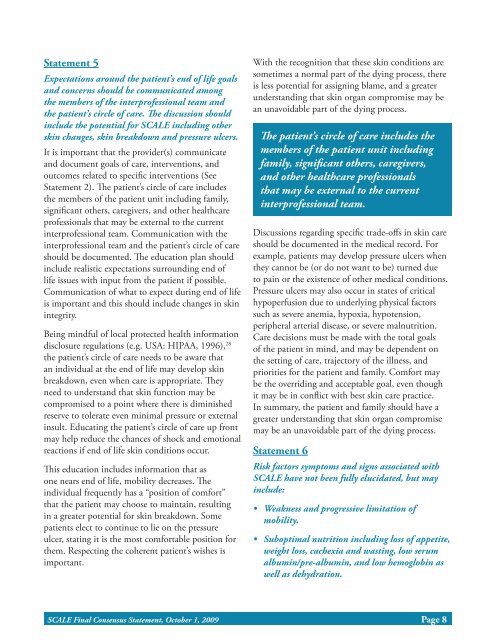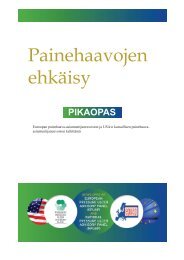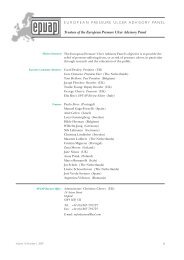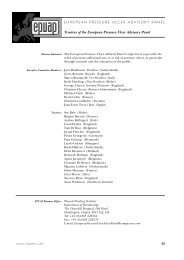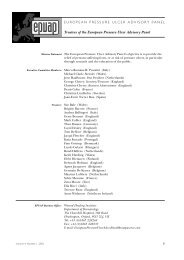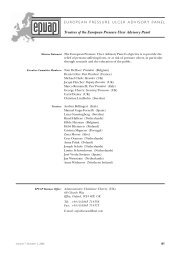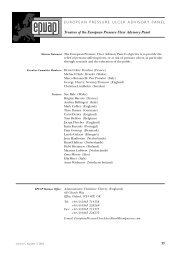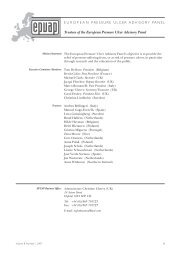SCALE Final Consensus Statement - European Pressure Ulcer ...
SCALE Final Consensus Statement - European Pressure Ulcer ...
SCALE Final Consensus Statement - European Pressure Ulcer ...
Create successful ePaper yourself
Turn your PDF publications into a flip-book with our unique Google optimized e-Paper software.
<strong>Statement</strong> 5<br />
Expectations around the patient’s end of life goals<br />
and concerns should be communicated among<br />
the members of the interprofessional team and<br />
the patient’s circle of care. The discussion should<br />
include the potential for <strong>SCALE</strong> including other<br />
skin changes, skin breakdown and pressure ulcers.<br />
It is important that the provider(s) communicate<br />
and document goals of care, interventions, and<br />
outcomes related to specific interventions (See<br />
<strong>Statement</strong> 2). The patient’s circle of care includes<br />
the members of the patient unit including family,<br />
significant others, caregivers, and other healthcare<br />
professionals that may be external to the current<br />
interprofessional team. Communication with the<br />
interprofessional team and the patient’s circle of care<br />
should be documented. The education plan should<br />
include realistic expectations surrounding end of<br />
life issues with input from the patient if possible.<br />
Communication of what to expect during end of life<br />
is important and this should include changes in skin<br />
integrity.<br />
Being mindful of local protected health information<br />
disclosure regulations (e.g. USA: HIPAA, 1996), 28<br />
the patient’s circle of care needs to be aware that<br />
an individual at the end of life may develop skin<br />
breakdown, even when care is appropriate. They<br />
need to understand that skin function may be<br />
compromised to a point where there is diminished<br />
reserve to tolerate even minimal pressure or external<br />
insult. Educating the patient’s circle of care up front<br />
may help reduce the chances of shock and emotional<br />
reactions if end of life skin conditions occur.<br />
This education includes information that as<br />
one nears end of life, mobility decreases. The<br />
individual frequently has a “position of comfort”<br />
that the patient may choose to maintain, resulting<br />
in a greater potential for skin breakdown. Some<br />
patients elect to continue to lie on the pressure<br />
ulcer, stating it is the most comfortable position for<br />
them. Respecting the coherent patient’s wishes is<br />
important.<br />
With the recognition that these skin conditions are<br />
sometimes a normal part of the dying process, there<br />
is less potential for assigning blame, and a greater<br />
understanding that skin organ compromise may be<br />
an unavoidable part of the dying process.<br />
The patient’s circle of care includes the<br />
members of the patient unit including<br />
family, significant others, caregivers,<br />
and other healthcare professionals<br />
that may be external to the current<br />
interprofessional team.<br />
Discussions regarding specific trade-offs in skin care<br />
should be documented in the medical record. For<br />
example, patients may develop pressure ulcers when<br />
they cannot be (or do not want to be) turned due<br />
to pain or the existence of other medical conditions.<br />
<strong>Pressure</strong> ulcers may also occur in states of critical<br />
hypoperfusion due to underlying physical factors<br />
such as severe anemia, hypoxia, hypotension,<br />
peripheral arterial disease, or severe malnutrition.<br />
Care decisions must be made with the total goals<br />
of the patient in mind, and may be dependent on<br />
the setting of care, trajectory of the illness, and<br />
priorities for the patient and family. Comfort may<br />
be the overriding and acceptable goal, even though<br />
it may be in conflict with best skin care practice.<br />
In summary, the patient and family should have a<br />
greater understanding that skin organ compromise<br />
may be an unavoidable part of the dying process.<br />
<strong>Statement</strong> 6<br />
Risk factors symptoms and signs associated with<br />
<strong>SCALE</strong> have not been fully elucidated, but may<br />
include:<br />
• Weakness and progressive limitation of<br />
mobility.<br />
• Suboptimal nutrition including loss of appetite,<br />
weight loss, cachexia and wasting, low serum<br />
albumin/pre-albumin, and low hemoglobin as<br />
well as dehydration.<br />
<strong>SCALE</strong> <strong>Final</strong> <strong>Consensus</strong> <strong>Statement</strong>, October 1, 2009 Page 8


